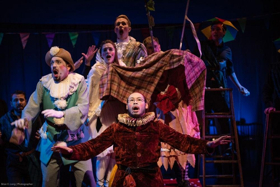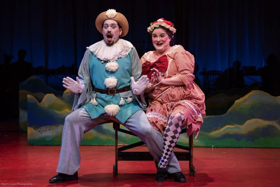Review: Dell'Arte Opera Unlocks the Cypher of LA CIFRA by Salieri

Timothy Stoddard (rear), Angky Budiardjono (front),
Stephen Steffens. Photo: Brian Long.
Before there was Wolfgang Amadeus Mozart, there was Antonio Salieri. Today, most people only know the latter as a character in the play AMADEUS and its Oscar-winning film version, and not as head of all things musical in Vienna for decades and a prolific composer.
You've got to give points to New York's spunky little Dell'Arte Opera Ensemble for digging up Salieri's LA CIFRA (THE CYPHER). It's an opera buffa that was popular in its time (1789) but never before done in this country, until Dell'Arte gave it a premiere for four performances last week.
The plot by Lorenzo da Ponte is typical of the buffa style, with mistaken identities, hidden treasure, thwarted love and, of course, a happy ending. Dell'Arte's charming no-frills production--with a bang-up cast of singing farceurs, a couple of better than average arias and an ensemble deftly led by Catherine O'Shaughnessy--however, was unable to prove that the opera's long obscurity was undeserved.

Photo: Brian Long
Back when the Met opened its new production of COSI FAN TUTTE last spring, there was a note in the program about its development. Before Mozart got his hands on the da Ponte libretto, Salieri--he, the villain of AMADEUS, and court composer in Vienna for 36 years--had taken first dibs on it but bowed out long before he made much headway.
I wonder whether he abandoned COSI for LA CIFRA, another work by the same librettist, a previous collaborator, at about the same time. For me, it's a much more appealing work than COSI, as far as the libretto goes, without the cynicism and misogyny that makes COSI sink like a stone. Alas, we'll never know, though records show that it was written for Adriana Ferrarese del Bene, the first Fiordiligi of COSI (and one of the first Susannas in LE NOZZE DI FIGARO).
Da Ponte, of course, is best known for his trio of operas with Mozart: LE NOZZE DI FIGARO, DON GIOVANNI and COSI, but that doesn't nearly cover his career. He wrote the libretti for 28 operas by 11 composers, including at least five with Salieri, most disappearing without a trace, except as excerpts on a Salieri album from Cecilia Bartoli a few years back. She featured a pair of excerpts from Act II: "E voi da buon marito...Non vò già' che vi suonino" and "Alfin son sola...Sola e mesta"--both charming but not world-beaters. (NB: There was also a performance of LA CIFRA in Cologne, Germany, in 2006.)
Director Brittany Goodwin kept the piece barreling along, giving it the feeling of more substance than the libretto and score might deserve and offering the cast a chance to shine. Among them, mezzo Allison Gish was hilarious to the nth degree as Lisotta, the daughter who wished she was a countess, while baritone Angky Budiardjono was a scene stealer as her father, Rusticone, and baritone Jay Lucas Chacon was amusing as her patient betrothed, Sandrino.
Soprano Rachel Barker-Asto did some lovely singing as the sister, Eurilla, who was really the countess. (She also gets that aria, "Sola e mesta" mentioned earlier, and does well by it.) Tenor Timothy Stoddard sang fluidly as Milord (the nobleman in disguise whose arrival sets the plot in motion, looking for that lost countess) and another tenor, Stephen Steffens, provided laughs and voice to the role of Leandro, his manservant.
Claire Townsend's costume design added much to the proceedings, while Matthew Iacozza's scenic design and Dante Olivia Smith's lighting design also contributed to keeping the opera in motion.
There are things about CIFRA that remind me of the early Mozart opera, LA FINTA GIARDINIERA (with a different librettist), which On Site Opera did in an abbreviated version last year, as THE SECRET GARDENER. They had the good sense to cut it down to size--90 minutes or so without intermission--while this one ran nearly three hours. I appreciate the desire for doing its US premiere with the unadulterated score, but a little cutting--particularly when it could deep-six the intermission--definitely seemed in order. Indeed, sometimes less is more.
Videos

